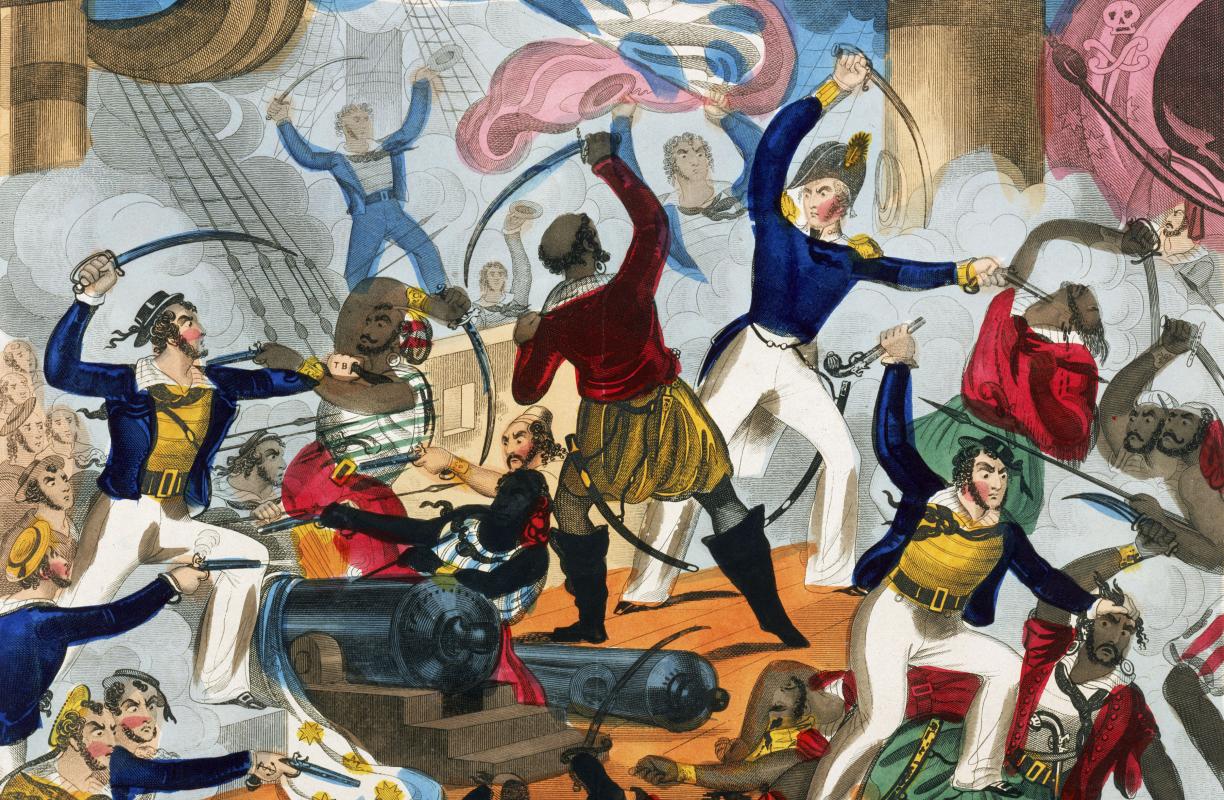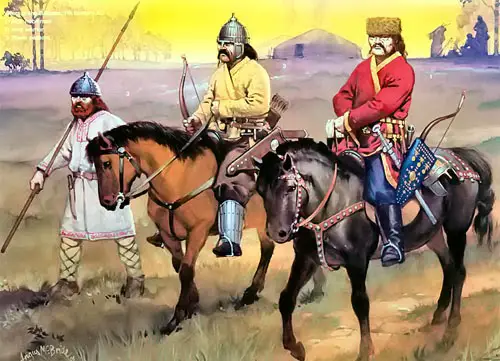
[Image source.](https://commons.wikimedia.org/wiki/File:British_sailors_boarding_an_Algerine_pirate_ship.jpg)
---
Everybody knows what a Saber it is a sort of sword or a handheld weapon from ages ago. Used throughout history by many armies, everybody knows of the saber as a pirate weapon. Captain Jack Sparrow and the rest of pirates waving their sabers around. Today is used by many militaries throughout the world as a ceremonial weapon manly during parades, state ceremonies or honor guard.
Let's take a look first at what kind of weapon the saber is really and after that, I will try to explain where it came from and why it is still in use today
First of all, it is a sword which is obvious to everyone I think, but and there is always a but it is not technically a sword because it has only one sharp edge. This brings us to the second piece of information what was the use of a one edged sword? Well, it was intended for the cavalry so for the use on horseback or in other words it was used from a higher advance position. That is also the reason why it has a curved blade with one edge because one uses a slashing motion to injure or kill your opponent. So in a battle when you ride your horse one uses the saber swinging it from above downwards in one continues motion. Believe me, it sounds lame and ineffective but the saber was one of the most feared weapons in history and twice as damaging.
But where did this weapon came from? it was not used in Europe during antiquity and the Romans did not know of it. Neither was it used by any army in the middle ages. Well, it did not fell of a try, so how and when did it arrive here? The saber was first encountered here in Europe during the 6th and 7th century so we are talking about the late antiquity early middle ages and it was brought here by the Avars.

[Image source.](https://archeryhistorian.com/avar-archery/)
---
So the Avaric tribes most of you probably never heard of them and an explanation is in order. These tribes arrived in Europe around the 5th century and established there own kingdom in central Europe known the Arar Khaganate. There were a nomadic tribe and were fearless warriors going to battle on horseback. They were famous for there archery skills on horseback their origins are unknown. They left as they came quickly and leaving mayhem behind. The Avars probably came from the east like Russian steps or the Caucasus. Many scholars describe them similar to the Huns, Mongols, and Hungarians as nomadic horse people very good at war superior to many armies of that time.

2000 year old straight singel edge saber. [Image source](http://www.arscives.com/historysteel/cn.steelswords.htm)
---
Where ever the Avaric tribes came from they are not credited for the development of the saber but they were the first to carry it out of Asia. The oldest traces of the proto saber can be located in Asia in the area of today's China and Korea. The proto saber emerged during the Han Dynasty from the 2nd century BC to the 2nd century AD. These sabers or swords are known as Dao sabers or Ring Pommel swords. There were made of steel or bronze and it was a straight single edge saber with a ring-shaped pommel. The ring at the end of the handle had a use, soldiers used to tie a piece of cloth to the end which was then tied to the arm so the sword does not get lost during battle leaving the soldier defenseless. One more thing is that swords were expensive and losing it was a dumb thing to happen.

Map of the Avaric Kaghanate in Europe. [Image source.](https://en.wikipedia.org/wiki/Avar_Khaganate)
---
So we learned about the oldest sabers From China and this brings us back to the Avaric tribes mentioned above. The Avars established their kingdom as they arrived Europe, in the Pannonian basin. Remains of there presence have been found in warrior graves and archaeological research in Serbia, Croatia, Hungary and other European countries. They came in two waves so to say and the first period of their presence is known as the First Avaric Kaghanate or Early Avar Period from the end of the 6th to the end of the 7th century. The brought with them another version of the straight saber known as the Paloš or Palas sword. Again like the Chinses swords, these ones are straight with a single edge. They are a little bit slimmer than the Chinese ones without the ring pommel. One example was Found in Syrmia, Serbia in the grave of an Avar warrior the burial was complete with the horse he owned.

Avar paloš straight saber. *Image source, Aralica T., Svesvete, 2006.*
---
A unique paloš saber found in Ukraine, Malo Pereshchepin belonged to the great Khan Kubrat the leader of the Onogundur Bulgars. His grave was filled with treasures, gold and silver coins he lived during the mid 7th century. Among the finds was the paloš made of gold and silver.

Khan Kubrats goledn paloš saber.[Image source.](http://earth-chronicles.com/histori/one-of-the-largest-treasures-found-in-europe.html)
---
The Avaric tribes started the second wave of migration into eastern Europe. They formed their second kingdom known as the second Avaric Khaganate from 670 AD to 796 AD. With them arrived a new form of the saber this time it looked more and more like the one we know today. These sabers had lightly curved blades and a innovation the was brought to the sabers construction the cross-guard. This is an important part of the evolution of the saber, this small detail shows us that the weapon was intended for close combat and not just from horseback. The cross-guard had the task to guard the hand against serious injuries which could only occur in close combat and the encounter with another sword. These sabers have been found in a few eastern European countries like Hungary, Croatia, Serbia, Bulgaria and more.


Cross-guard and lightly curved saber from the second Avar period. *Image source, Aralica, T.,Zagreb, 2012.*
---
So in this post, I wanted to show you the reader the development of the saber. This weapon was unknown in Europe during antiquity and the early middle ages and encounters with nomadic warrior occurred from time to time. Armies were mostly made out of the infantry during the middle ages and only the nobility would use horses large cavalry units were unnecessary. Attacks by these nomadic tribes would mostly be waited out in fortresses, the attacks were swift and quickly and they dispersed as they came robing and plundering. During the time of the early middle ages, the saber as a cavalry weapon was not adopted by the Europeans in their encounters with forging armies. It is not until 500 years later when new enemies arrive that the saber became used by the nations of Europe. The arrival of the Hungarians and the Ottoman Turks change the way of warfare of the Europeans During the 14th and 15th century.

[Image aource](https://chechar.wordpress.com/category/mongols/)
---
This brings us to the end of my post on a brief history on sabers and we stopped at the end of the early middle ages. If you are interested in more facts about the saber and its further development please let me know in the comment section.
If you have any questions please let me know in the comments below and a resteem would be nice :)
Good luck to all of you until next time @zija2022.
### Bibliography
---
* Aralica, T., *Križnica sablje ili paloša Drugog avarskog kaganata iz Nina*, Prilozi instituta za arheologiju u Zagrebu, Zagreb, 2012.
* Aralica, T., *Sablje na tlu Hrvatske od VI. do XX. stoljeća*, Svesvete, 2006.
* Bošković, D., Doračić, D., *Mačevi viteškog doba u Hrvatskoj*, Zagreb, 2010.
* Kovač, M., *Ubojite ostrice : hladno oruzje na podrucju Hrvatske od IX. do kraja XVIII. stoljeca *, Gornja Stubica, 2003.
* Kovač, M., *Mačevi, bodeži i oružja na motki u Istri*, Primorju i Dalmaciji od IX. do kraja XVIII. stoljeća, Pula, 2005.
* Šercer, M., *Oružje u prošlosti*, Zagreb, 1980.
* Sijarić, M., *Mačevi 10. do 15. stoljeća iz Bosne i Hercegovine*, Sarajevo, 2004.
A brief history on weapons - The Saber
@zija2022
· 2018-03-22 11:23
· steemstem
#steemstem
#curie
#thesteemengine
#history
#archaeology
Payout: 0.000 HBD
Votes: 290
More interactions (upvote, reblog, reply) coming soon.